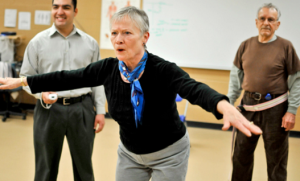Hit ‘em With a Stick – Use Perturbations to Train Balance and Core Stability
Posted by Steve Hochman on Thu. Feb. 13th, 2014
Guest Post by Cody Sipe, PhD
Almost all mature clients need to include training for balance and core stability in order to improve activities of daily living, reduce risk of injury and prevent falls. There are many ways to train these specific areas, and you should learn some of them if you want to know how to be a personal trainer that is well rounded. One method that is effective yet seldom used is perturbation training.
Reactive and Proactive Postural Control
Postural control is by definition the ability to control the body’s position in space in order to control the center of mass relative to the base of support and to maintain the appropriate relationships between the body and the environment. There are two basic types of postural control: reactive and proactive. Reactive postural control is the ability to recover after an unexpected perturbation (i.e. push, pull, shove, slip, trip, etc.).

For example, when a person is bumped unexpectedly from behind they must react to the perturbation quickly and appropriately if they are to remain upright. If the bump is strong enough then it might also require the person to take a compensatory step in order to keep from falling.
Proactive (or anticipatory) postural control is the ability to modify postural control before a perturbation occurs in order to maintain stability. In essence, the person knows the perturbation is coming and reacts in order to be able to keep from being destabilized by the perturbation. For example, when a person sees that a person is about to bump into them then they change their posture accordingly. Typically this means that they lower their center of mass, lean in the direction of the coming perturbation and tighten their core musculature.
Both reactive and proactive postural control is important to train because while there is definite overlap between the two there are also distinct differences. Reactive postural control relies heavily on somatosensory information coming from touch and proprioception. Perturbations that are unexpected turn on proprioceptors to a much greater degree than perturbations that are expected. However, how quickly that information is processed and then turned into appropriate compensatory muscle activation varies.
The point of training older clients using perturbations that are unexpected is to teach their nervous system how to react quickly and effectively when their postural control is challenged. Individuals that cannot react quickly and appropriately will lose their balance because their center of mass will get pushed outside of their base of support or will cause their spine to flex. This increases the chance that they will trip, fall or become injured.
Proactive postural control relies heavily on visual information to estimate the force parameters such as direction and magnitude in order to scale an appropriate response. When a person sees that, for example, a person is about to bump into them they quickly determine how to change their posture or take an evasive action in order to either absorb or avoid the perturbation. Experience in similar situations helps the individual to determine what kind of response to make.
Multiplanar Core Stability
It is the primary purpose of the core musculature to stabilize the spine and keep it in neutral position during human movement – activities of daily living, recreational activities, sports, work tasks, etc. This requires counteracting forces in the sagittal, frontal and transverse planes…and many times multiple planes simultaneously. Sometimes this is unexpected and sometimes it is expected thus the need for including perturbations that challenge both reactive and proactive postural control.
Balance
Balance is multi-factorial. It relies on proper multisensory input (visual, vestibular, somatosensory), processing and appropriate motor output. A perturbation has the potential to displace a person’s center of mass towards the limits of their base of support (determined by their stance position). When this occurs the individual can employ either an ankle or hip strategy to keep the center of mass over their base of support.
A potential fall situation occurs when a person’s center of mass is displaced outside of their base of support. In order to prevent a fall the person can recover by taking a step. So in addition to postural control (postural stability) perturbations can be effectively used to train appropriate ankle, hip and step strategies in order to improve balance and decrease the chances of a fall.
How to Perturb Your clients
So you really don’t want to actually hit your clients with a stick but then again that’s pretty much what you do. Okay, it’s really more like poking and pushing… and you don’t even need a stick. Your hands will do just fine. Frankly, lots of different pieces of equipment such as bars, hands, boxing gloves, swiss balls and even resistance tubes will work.
The primary areas that you want to actually push on are the bony areas of the hips and shoulders. Pushing on the midsection is typically uncomfortable for the client and absorbs the force which is counterproductive. Here are several tips for performing perturbations safely and effectively:
· Don’t “jab”, push (or pull) instead
· The amount of speed and force should vary but be large enough to create a postural response
· Alter the direction and angle of the force in order to train multiplanar stability
· Begin with static perturbations before moving to dynamic perturbations
· Include both shoulder level and hip level perturbations
· Spot the individual to make sure they don’t fall
· Conduct the perturbations in an open area free from trip hazards
-Cody Sipe, PhD
Posted in Boot Camp Business, Fitness Business, Personal Training Business by |

